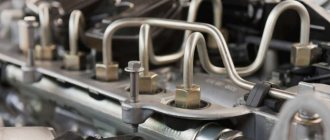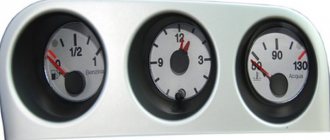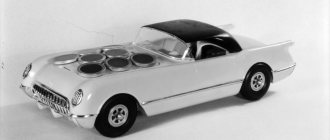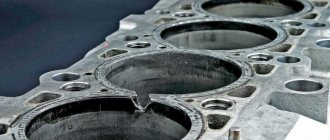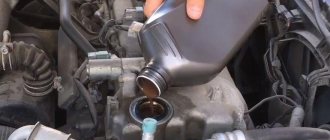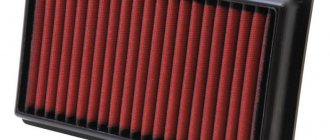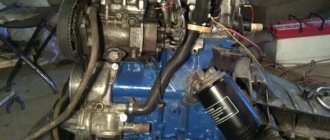Hi all! The automotive industry is constantly evolving and improving. At the same time, not everyone has heard or knows anything about water injection into the engine.
Yes, everyone knows that there is a cooling system that runs practically on water with special additives. There is also an exhaust system in which sometimes water drips from the pipe. But still, it is necessary to say that water is specially supplied to the motor in order to increase the efficiency of its performance. No matter how strange it may sound.
But let's look at this issue in more detail. Let's find out why and who does this, why adding steam or water can provide some advantages, and how things stand in the modern automotive world.
How it works
Having at their disposal a diesel or gasoline engine, a traditional atmospheric injection engine or even a turbo engine, few people would think of intentionally introducing water into the cylinders.
Skeptics will say that feeding water into a carburetor or any other engine will only lead to water hammer.
see also
Radiator grille: DIY tuning
But here it is important to understand one nuance. There is such a thing as water hammer, which is caused by a large amount of liquid entering the engine through the intake tract. This can happen when driving through a deep puddle. But there are systems that you can even assemble with your own hands using Arduino or buy through Aliexpress, which carry out a small injection of a special mixture. Such developments have become more widely used in high-power machines. They are unlikely to be suitable for conventional internal combustion engines. But you can install it on a gas turbine unit.
Water injection is used to improve engine efficiency and performance. Additional power can be obtained in different ways, depending on which system will be used.
Typically, a special injector is installed on the intake manifold. When talking about water, many people are lying. In fact, a mixture of water and methanol is supplied. It is mixed with the air-fuel mixture.
Not everyone understands why a combination of water and alcohol is used. This mixture has a fairly low freezing point. Plus, this combination allows you to obtain a liquid with a better dispersion effect. That is, it is possible to create a uniform mixture and at the same time reduce the temperature in the intake manifold section. Small drops cool the mixture, thereby increasing the compression ratio, reducing the rate of combustion of the mixture inside the cylinders, while simultaneously reducing the likelihood of such an effect as detonation.
Additionally, a drop in temperature indicators has a positive effect on the chemical processes occurring inside the combustion chamber, and the level of harmful emissions from the exhaust system decreases.
avtoexperts.ru
Sooner or later, in any automotive community, the topic of water injection into the engine usually arises, they say, someone somewhere heard that it increases power and reduces fuel consumption. The topic attracts many, because it seems like manna from heaven - you don’t have to fence the turbines, don’t install nitrogen, but simply inject free water into the engine and it will immediately be transformed. It seems too incredible to be true. But in fact, the “water” issue is still more interesting than it seems at first glance - there is a benefit from injecting water into the engine, but there is no point in installing it. Confused? Let's figure it out.
Water injection into the engine
The fact that adding water to the engine could be a good idea was thought about more than 100 years ago, and not by some garage tuners, but by quite decent factory engineers. True, at first the technology was used by the aircraft engine industry, but the automotive industry also looked at the idea. In the post-war years, there was even a production car in which water injection was implemented at the factory - the Oldsmobile F-85 Jetfire.
1962 Oldsmobile F-85 Jetfire
GM used water to combat detonation. Then Saab worked with this topic for a long time, and not several models at once.
1967 Saab 99 Turbo
Even today, the BMW M4 is produced, in which one of the engines also uses this technology. What can I say, even in Formula 1 in the early 80s, before the introduction of a direct ban, some teams installed similar systems and received an increase in power. If so many smart engineers worked on this topic, does it mean that water injection makes sense?
BMW M4 Coupe with water injection system into the engine
Why does it help?
Yes, it makes sense. This may be difficult for a person far from physics to understand. How is it that the engine runs on gasoline, why does adding water somehow improve its performance? But in fact, everything is logical - water allows you to cool the fuel-air mixture, which in itself is not bad (to compress the cooled mixture you need to spend less energy, which means the engine will transfer more power to the wheels), and when it gets into the cylinder, it also evaporates and slightly increases the compression ratio, which is precisely what gives an increase in power. In addition, water increases the combustion rate, which can significantly reduce detonation. Over the years, engineers have solved different problems using water injection. Before the advent of intercoolers - cooling the mixture, after their appearance - a short-term increase in power, in everyday life - a decrease in the octane number of the fuel.
Oldsmobile F-85 Jetfire engine diagram
The technical implementation of injection can be different, but in the most primitive versions it is very cheap. Any container, a hose from a dropper, a windshield washer motor, a nozzle for spraying into the intake manifold, a simple electrical circuit. But this, of course, is unreliable and risky - a little too much with the water supply and hello, water hammer. Today, injection systems with computer control based on data from a sensor have already been invented; this allows the system to operate stably, but also, of course, increases the cost of installation. Now many companies have started selling ready-made kits - but they cost $800-1000.
Water injection kit for AQUABAST WI-2.0 engine
Why shouldn't you put
After reading the last section, many readers probably had an idea why the water injection system is still not installed on all cars in the world, if it is relatively simple to implement and improves engine performance. And of course there are reasons for this.
Firstly, the presence of water in the mixture worsens emissions, and environmental standards are becoming stricter and stricter; automakers do not want to deal with this problem at all.
Engine water injection system
Secondly, setting up water injection so that it works stably is not an easy task, especially when it comes to injection into the intake manifold. No matter how you position the injector, the filling of different cylinders with water will still be different, and this almost guarantees unstable operation at full power and at low speeds under load. The technology of distributed water injection could theoretically solve this problem, but the cost of the issue is already beginning to affect it - today, for budget cars, even distributed injection of gasoline is too expensive and complicated, let alone water.
Installed system
Thirdly, water for the end consumer is not free. Tap water should not be used for injection into the engine. Or rather, of course, it is possible, but due to salts and additives, the walls of the engine cylinders will be covered with deposits within a couple of thousand kilometers (remember kitchen kettles!), and then there will be trouble with the engine. So, at a minimum, you need distilled water. But in a good way, you need to add methanol to it so that it can be used in winter and the engine runs smoother. That is, in addition to the cost of gasoline, the car owner has a need to buy (well, or make it himself) injection fluid. And this is unlikely to reduce operating costs.
Real example
The economic dubiousness of using water in the mass automotive industry can be seen precisely in the example of BMW. Engineers report that using water, it was possible to increase engine power by 14 hp, while fuel consumption decreased by 8%. The system consumes 1.5 liters of water-methanol mixture per 100 kilometers. The water tank is 7 liters, which means you need to fill it up every 500 kilometers, about the same as gasoline. Yes, the car will work normally without water, but without any increase in power or economy. So we think that the benefit on gasoline is not that big, there is an increase in horsepower, but it’s also not global, and there are a lot of hassles with the system. For a regular car it won't pay off.
Under the hood of the BMW M4 Safety Car with water injection system
But in racing, where “we don’t stand behind the price,” the water injection system is very justified, especially in drag (although there you have to compete with nitrogen), where the resource is not important, the cost of operation is also, and every tenth of a second removed from the result increases the chances to win. However, the same problems that can be solved with the help of water can be solved in other ways, so this is also an optional question.
So it turns out to be a paradox: injecting water into the engine actually improves its performance, but due to a combination of factors, such systems almost never justify themselves, no matter how much some dreamers would like to refuel from the water supply and drive at full power.
back side
In addition to the obvious and discussed advantages, such systems also have their disadvantages.
This is far from an ideal system, which is largely reflected in its active use.
see also
How to sell a credit car legally: suitable methods
As a result of work, exhaust gases are formed. They contain an increased concentration of hydrocarbons that do not burn. This negatively affects fuel consumption figures. If the speed is low or the throttle valve is fully open, unstable operation of the power unit is observed. The main reasons for this behavior include the uneven distribution of liquids in the cylinders. Some cylinders are bound to have an excessively lean mixture.
This problem is being resolved. To do this, you can put an individual nozzle on each of the cylinders, which will be controlled by a computer.
It is important to understand that when adding the mixture, you must use strictly distilled water.
If you add plain water, carbon deposits will certainly form inside the combustion chamber, the service life will decrease, and the motor will fail prematurely.
The effect of the presence of water in the composition of a combustible mixture
As already mentioned, water injection was originally used to combat detonation. However, as a rule, a solution of water and methyl alcohol in various proportions was used. It was experimentally found that the optimal ratio is 50/50. The solution itself plays the role of an anti-knock additive, and boosting the engine was initially a side effect that was not immediately recognized. In addition, water is an antioxidant and prevents the formation of carbon deposits in combustion chambers.
What happens in the combustion chambers when an aqueous solution of methanol is injected?
- Water has a high heat capacity, which significantly reduces the temperature in the internal combustion engine cylinders.
- Since colder air is much easier to compress, significantly less energy is expended during the compression stroke, i.e., engine efficiency increases.
- In addition, it becomes possible to drive more air into the cylinders, and the water, evaporating, creates additional pressure, increasing the compression ratio.
- The liquid enters the cylinders in an atomized state and is instantly enveloped in gasoline particles, as a result the working mixture becomes more homogeneous, fills all available space well, and burns more evenly. This provides an additional increase in efficiency and reduces the likelihood of detonation. Thus, the power of the internal combustion engine increases by approximately 10% .
As for methyl alcohol, its combustion process occurs at a lower speed than that of gasoline, therefore the increase in pressure in the cylinders proceeds more smoothly, and the maximum value is reached later. The result is increased torque and power.
Ideally, the greatest amount of water should be injected at the peak of torque. The ratio of water and air should be between 1/10 and 1/14. With less air, the working mixture will not burn completely, which will be indicated by “shots” in the muffler, and if there is a lack of water, detonation may occur.
Current situation
I won’t go into detail, but I will say that the development of a water system to improve engine efficiency began at the beginning of the 20th century, but became most widespread during World War II. The system was used for aircraft and helicopters participating in hostilities from Germany and the United States.
The Porsche 911, which in 2005 set a speed record among cars approved for use on regular roads, accelerated to 388 kilometers per hour using water injection systems. Then they forgot about the system for a while, and interest in it dropped. But in 2015, specialists from BMW returned to it again. Only now gas (water-methane mixture) units were used to reduce fuel consumption, and not to increase power. The first car was a pace car based on the BMW M4, which was part of the MotoGP series of motorcycle racing.
BMW specialists used several interesting ideas. One of them was that when the interior air conditioning system was operating, the resulting condensate entered a special tank. This solved the problem of extracting water for the mixture. As a result, gasoline savings fell by 8% compared to a conventional engine.
A brief excursion into history
For cars in the first half of the twentieth century, the power of the internal combustion engine was not of decisive importance. Unlike car designers, aircraft engineers fought for almost every horsepower. For this reason, the injection of water, or rather its mixture with methanol, in mass quantities was first used on aircraft when the internal combustion engine was operating in afterburner mode.
The pioneer in this area was the German Messerschmitt Bf.109 G-6 (“Gustav”). It was on this fighter, the production of which began in the fall of 1942, that the MW 50 system (from Metanol-Wasser) began to be installed, the number indicating the percentage of methyl alcohol. There were other systems: MW 0, MW 30, MW 75 and even MW 100, which injects pure methanol. However, practice has shown that the best boost to the internal combustion engine is achieved by injecting a 50% alcohol solution.
If we talk about specific figures, the engine of this Messer in afterburner without methanol injection at an altitude of 1 km developed a power of 1575 hp. s., and the included MW 50 system added another 225 hp. With. (total power increased to 1800 hp). As a result, the maximum speed of the aircraft increased by about 40 km/h, which gave a great advantage in battle.
Water injection has also found its application in American aviation. Soviet engineers did not go further than prototypes. Further, with the advent of jet engines, the question of the need to inject water into piston internal combustion engines of aircraft disappeared by itself.
Working principle of dry washing
Sometimes, if it is necessary to carry out cleaning, the driver refuses to use dry washing due to the fact that he is not familiar enough with this technology. One of the main concerns is the lack of understanding of what it is, the fear that the abrasive elements included in the cleaning substance may be harmful to the car's coating. However, this problem has now been resolved and the corresponding concerns are not relevant.
Such cleansers resemble an emulsion in appearance. When processing, it is sprayed onto the surface of the treated area. This product envelops particles of dust and dirt, making them easy to clean with a fiber cloth.
The emulsion contains:
- surfactants;
- corrosion inhibitor;
- silicones.
After the dirt has been cleaned, you will need to wipe it again with a cloth with a polishing compound. After the dry car wash is completed, a protective film will appear on the cleaned surface, which is resistant to dirt and water. At the same time, the cost of washing is lower than during a conventional procedure.
Dry washing is carried out using a special emulsion and rags
How to remove water from the muffler
There are several ways to remove water from the muffler and prevent its massive formation.
The simplest and least dangerous way is to dry the muffler by heating it up. As mentioned above, during engine operation, the temperature of the muffler increases significantly, which leads to the conversion of accumulated water into steam. That is, in order for the muffler to warm up enough and have time to get rid of water, you need to either minimize short trips by car, or make long trips from time to time so that during this time the muffler has time to get rid of excess water.
It is especially important to take long rides to get rid of water during the colder months. At least once a month in winter, spring and autumn it is necessary to make trips lasting at least an hour, preferably at high speed - that is, on the highway
During this time, the exhaust gases will have time to heat up the muffler, and the water will evaporate.
A difficult way to get rid of water in the muffler is to drill it. If you decide to take such measures, you should know that you need to drill the last “can” of the resonator with a thin drill (about 2-3 mm).
Please note: You can find advice online that it is necessary to drill holes in all (or almost all) resonators in order to get rid of water completely. We do not recommend doing this
The method of removing moisture from the muffler by drilling holes itself is quite controversial. There are several negative aspects that it leads to:
- Hole formation. Even if the work is carried out with a thin drill, the surface of the resonator will still be damaged. Over time, elements of corrosion will begin to appear on it, and a small hole will begin to grow;
- Exhaust gases entering the cabin. If you drill several “cans”, then there is a high risk that the exhaust gases will partially begin to be directed into the car’s interior;
- Change in exhaust sound. The noise from the car's exhaust may increase, or the sound will become louder, which may generally cause discomfort.
(158 votes, average: 4.47 out of 5)
Methods for constructing an injection system
Craftsmen have developed two injection methods:
In general, injecting water into an engine with your own hands is relatively easy. The main thing is to calculate the volume of water supplied.
Highlighting Weaknesses
As for the obvious disadvantages, these include the following:
- The exact installation requirements are too high. The slightest violation in installation technique and too much or too little water flow will destroy the stable operation of the engine.
- You will need to constantly purchase distilled liquid, since ordinary water cannot be used, and 10 liters of fuel will require approximately 2 liters of liquid.
- In winter, using such a system is not at all recommended, as the water will simply freeze.
Reviews about water injection into the engine are about as mixed as the system itself.
Reviews
Some motorists spoke rather flatteringly about its work, indicating that the system really improves the car's performance. Other drivers even said that the increase in power, decrease in temperature and other advantages are completely fictional and none of this works. There were those who noted a slight increase in parameters, but they said that for such a price this is too little compensation, and therefore you should not think about installing it. Experts also disagree on this matter.
Injection operating principle
Theoretically, the design of the injection system is extremely simple: a water nozzle is made in the intake manifold, which sprays this liquid into the fuel mixture. Water acts in two ways in this system. Firstly
, it cools the gasoline. And even from a school physics course it is known that a maximum of 45% of fuel is spent on providing power. In our case, roughly speaking, the rest of the amount is used to heat the street.
With this additional cooling, 70 percent of the gasoline is already used. At the same time, instantly evaporating upon contact with hot cylinders and pistons, water in the form of steam creates an additional pushing force, which pushes the piston out more energetically.
By the way, the idea is by no means new.
. It was conceptualized and described by a certain Englishman Hopkins about a century ago. And the Second World War, as already mentioned, gave impetus to the active use of injection in aviation by both the Americans and the Germans.
It will be useful: How to replace the timing belt on a VAZ 2115
